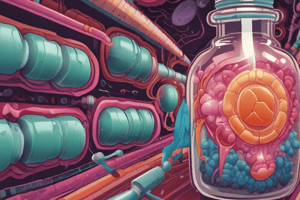Podcast
Questions and Answers
What effect does acid pH have on the accumulation of pyrazinoic acid inside M. tuberculosis?
What effect does acid pH have on the accumulation of pyrazinoic acid inside M. tuberculosis?
- Increases the metabolism of pyrazinoic acid.
- Increases the accumulation compared to neutral pH. (correct)
- Has no impact on the accumulation.
- Decreases the accumulation significantly.
Which part of PZA's chemical structure is crucial for its activity?
Which part of PZA's chemical structure is crucial for its activity?
- The pyrazine ring. (correct)
- The alkyl side chain.
- The hydroxyl group at C-3.
- The carboxylic acid group.
What is suggested to be a consequence of pyrazinoic acid accumulation?
What is suggested to be a consequence of pyrazinoic acid accumulation?
- Stimulation of bacterial metabolism.
- Facilitation of nutrient absorption.
- Disruption of membrane potential. (correct)
- Enhancement of bacterial growth.
What has been indicated about the substitution on the pyrazine ring of PZA?
What has been indicated about the substitution on the pyrazine ring of PZA?
Which of the following statements regarding QSAR and PZA is true?
Which of the following statements regarding QSAR and PZA is true?
What is the primary cause of tuberculosis (TB)?
What is the primary cause of tuberculosis (TB)?
How does Mycobacterium tuberculosis primarily thrive in the body?
How does Mycobacterium tuberculosis primarily thrive in the body?
What type of tuberculosis affects the central nervous system?
What type of tuberculosis affects the central nervous system?
What is the mechanism of action of Isonicotinic acid hydrazide (INH)?
What is the mechanism of action of Isonicotinic acid hydrazide (INH)?
What characteristic of M. tuberculosis cells renders them impervious to Gram staining?
What characteristic of M. tuberculosis cells renders them impervious to Gram staining?
Which statement about the structural activity relationship (SAR) of INH is true?
Which statement about the structural activity relationship (SAR) of INH is true?
Which route is NOT a method of transmission for tuberculosis?
Which route is NOT a method of transmission for tuberculosis?
What type of tuberculosis is characterized by the presence of multiple tubercules throughout the body?
What type of tuberculosis is characterized by the presence of multiple tubercules throughout the body?
What effect does replacing the pyridine nucleus with an aromatic ring have on antitubercular activity?
What effect does replacing the pyridine nucleus with an aromatic ring have on antitubercular activity?
Which substitution position of hydrazide leads to a less active compound?
Which substitution position of hydrazide leads to a less active compound?
What is the primary mechanism of action of Rifampicin?
What is the primary mechanism of action of Rifampicin?
Which components are essential for the antimycobacterial activity of Rifampicin?
Which components are essential for the antimycobacterial activity of Rifampicin?
What happens to the antimicrobial activity if the –OH group at C-21 and C-23 is acetylated?
What happens to the antimicrobial activity if the –OH group at C-21 and C-23 is acetylated?
How does Pyrazinamide exert its bactericidal effect against M. tuberculosis?
How does Pyrazinamide exert its bactericidal effect against M. tuberculosis?
What condition facilitates the conversion of pyrazinoic acid into its active form?
What condition facilitates the conversion of pyrazinoic acid into its active form?
Which compound's activity is significantly diminished if the macrocyclic ring is opened?
Which compound's activity is significantly diminished if the macrocyclic ring is opened?
Study Notes
Tuberculosis (TB)
- TB is an infectious bacterial disease caused by Mycobacterium species, primarily M. tuberculosis.
- TB is characterized by the growth of nodules (tubercles) in tissues, especially the lungs.
- M. tuberculosis has a waxy coating due to mycolic acid, making it resistant to Gram staining.
- M. tuberculosis is a strict aerobe, thriving in high oxygen tension environments, such as the apex of the lungs.
- Transmission occurs through inhalation, ingestion, inoculation, and transplacental routes.
Types of Tuberculosis
- Pulmonary TB
- Genitourinary TB
- Tuberculous meningitis
- Miliary TB
Anti-Tubercular (ATB) Drugs
- ATB drugs target the cell wall synthesis, DNA-dependent RNA polymerase, or other metabolic pathways essential for Mycobacterium growth.
Isoniazid (INH)
- INH is a prodrug activated by katG enzyme in M. tuberculosis.
- Activated INH, isonicotinic acid, inhibits mycolic acid synthesis, disrupting cell wall formation.
- The pyridine ring and hydrazine side chain are essential for activity.
- The N-1 nitrogen in the hydrazine side chain must be unsubstituted.
- Replacement of the pyridine ring with other aromatic structures diminishes activity.
Rifampicin
- Rifampicin is an antibiotic derived from Streptomyces mediterrianei.
- It inhibits DNA-dependent RNA polymerase by forming a stable complex, suppressing RNA synthesis initiation.
- It has bactericidal properties.
- The macrocyclic molecule is essential for activity; its integrity and presence of specific hydroxyl groups are crucial.
Rifabutin (Semisynthetic Refamycin)
- Rifabutin is a semisynthetic derivative of rifamycin with similar activity.
Pyrazinamide (PZA)
- PZA is a synthetic pyrazinoic acid amide derivative with bactericidal properties.
- PZA requires bacterial pyrazinamidase for activation, which converts it to pyrazinoic acid.
- Pyrazinoic acid disrupts membrane potential and interferes with energy production in M. tuberculosis.
SAR of PZA
- The pyrazine ring and amide group at C-2 are critical.
- Modifications to the pyrazine ring or using other heterocyclic aromatic rings decrease activity.
Studying That Suits You
Use AI to generate personalized quizzes and flashcards to suit your learning preferences.
Related Documents
Description
Test your knowledge about tuberculosis, its types, and treatment options. This quiz covers key points about the disease caused by Mycobacterium tuberculosis, including its characteristics and anti-tubercular drugs like Isoniazid. Discover how TB is transmitted and the various forms it takes in the body.



